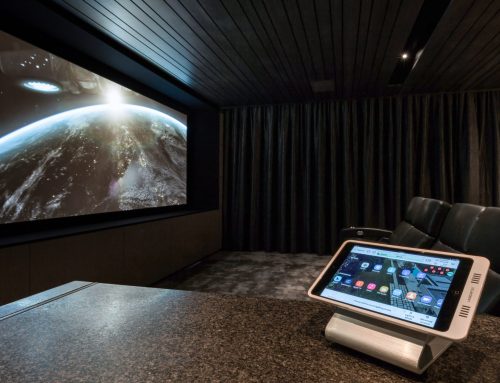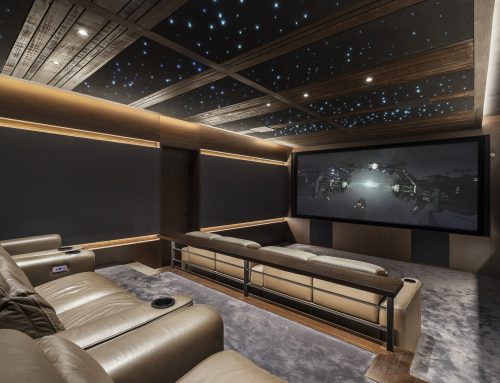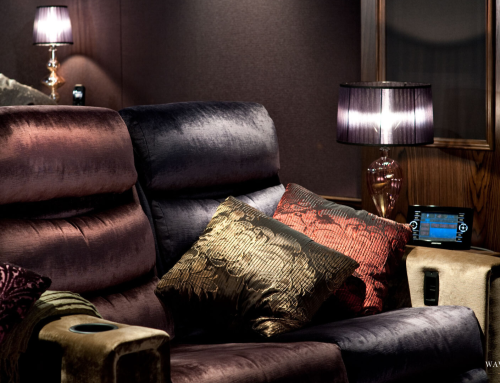When planning a high-end home cinema or media room, many people focus first on screens, speakers, and seating. What gets less attention, but is often far more critical, is the room’s size and shape. The dimensions and proportions you choose don’t just affect aesthetics; they directly determine sound quality, viewing comfort, projection performance, and how immersive the experience feels. Even a modest space can become a world-class cinema when designed thoughtfully from the ground up. Getting this right early on lays the foundation for everything that follows.

Why Size and Shape Are Crucial for High Performance Home Cinemas
1. Optimised Room Acoustics for Perfect Home Cinema Sound
- Resonance, reverberation, and standing waves: Rooms with odd or near-square dimensions often produce concentrated sound reflections, which can lead to echo, muddied dialogue, or boomy bass. The shape and proportions influence how sound waves bounce off walls, floor, and ceiling.
- Bass response: The location of the room’s corners and the distance between surfaces affect low-frequency behaviour. Rooms that are too shallow or too wide may suffer from uneven bass (some seats will boom, others sound weak).
- Sound isolation and clarity: Well-proportioned, elongated spaces make it easier to position speakers and treat the room so sound doesn’t mix undesirably. Directivity is better controlled, and absorption, diffusion, and bass trapping can be applied effectively.
“The room is a musical instrument and needs to be tuned before anything else can go in the room…”
– David Moseley, Wavetrain Founder & Director
This philosophy underscores that every decision – from wall angles to ceiling height – affects how sound behaves. Before adding speakers, screens, or seating, a well-tuned room lays the foundation for a truly immersive cinematic experience.
2. Ideal Screen Size & Projection Setup for Luxury Home Theatres
- Screen size vs. viewing distance: A huge screen in a tiny room causes eye strain or forces viewers to move their head frequently. Too small a screen and you lose impact. A common rule of thumb for high-end cinemas is around 6m long × 4.5m wide with high ceilings – though even smaller rooms can work with the right setup.
- Aspect ratio & projection throw: Projectors need enough throw (distance from screen) to produce large, crisp images without distortion. The room’s length sets limits on screen size unless you use ultra-short throw projectors. Ceiling height matters too, not just for mounting but to avoid keystone distortion and allow full use of vertical screen real estate.
3. Best Seating Arrangement & Sightlines for Immersive Cinematic Experience
- Optimal seating rows: The depth of the room dictates how many seats/rows you can have while maintaining good sightlines, comfortable distances, and appropriate angles to the screen.
- Comfort & immersion: Seats too far off-axis degrade image quality (colour, contrast). Seats too close can give neck strain or make the image feel overwhelming. Proper room proportions help ensure everyone has a great view and is comfortably positioned.

What Room Shapes Work Best For Luxury Home Cinemas
From both acoustic theory and what we’ve observed in many homes and installations, certain shapes tend to produce better results:
| Room Shape | Description | Pros | Challenges / What to Watch |
|---|---|---|---|
| Golden Ratio Rooms | Uses the golden ratio (≈ 1.618) in proportions (length : width : height). Many find this gives balanced acoustics and pleasing geometry. | Even sound distribution, less problematic modes, good visuals. | Harder to achieve in existing structures; may require custom build or room reconfiguration. |
| Golden Trapagon / Trapagon Shapes | Variant of rectangular forms where one short side is somewhat longer; similar to “Golden Cuboid” or “Trapagon” described in acoustics literature. | Reduced echo & reverb; can help focus sound; visually pleasing layouts. | May lead to wasted space or awkward furniture layout if not planned well. |
| Typical Rectangles | Most practical rooms will be rectangular. With proper ratio and treatment, these often perform very well. | Easier to furnish, simpler to treat acoustically, more common in housing. | Beware of square rooms; they tend to create bad acoustic modes (sound booms, uneven distribution). |
What We’ve Seen: Perfect vs. Just-Enough Cinema Rooms
Our previous article “What is the Perfect Size for Your Home Theatre Room?” notes that while the ideal cinema room size is around 6m × 4.5m with high ceilings, many homeowners successfully transform smaller rooms into incredible home theatres, provided they plan carefully. See: https://www.wavetrain.com.au/what-is-the-perfect-size-for-your-home-theatre-room/
Key takeaways:
- Smaller rooms can work beautifully when the layout, seating, screen size, and equipment are tailored to the space.
- Avoid trying to cram too much into the room – the trick to a great system is balance:
- Screen size: Don’t try to force a screen that’s too large into a shallow room. Match the screen size and projector throw to the available depth and sightlines.
- Seating layout: Think carefully about who will use the room. For example, if you have a compact space (around 3 m × 4 m) for a family of five, it’s usually better to install two or three quality seats and add beanbags or a lounge for kids, rather than squeezing in five cinema chairs.
- Avoid multiple rows in small spaces: Trying to fit two rows of seating into a small room often compromises both comfort and performance.
- Positioning matters: Keep seats away from side and rear walls. Ideally, your head should be at least 50 cm away from any wall to maintain proper surround sound imaging and avoid acoustic issues.
Planning Stage for Your Home Cinema: What to Get Right Early On
To build the foundation for an excellent home cinema, these are the architectural and design items you want to get right before finishing or furnishing:
- Set your target room dimensions. Think of what is most important for you – your ideal screen size, how many seats you want, or whether you want the space to be multipurpose. Then work backward to determine minimum length, width, and height.
- Design for proper ceiling height. A common oversight in home cinema design is ceiling height. Higher ceilings allow for optimal projector placement, potential tiered seating, and prevent the room from feeling cramped or flat. A ceiling around 2.7 m is ideal, but if you know your room dimensions, you can also use the golden ratio to calculate the perfect height for your space.
- Mind the proportions. Try to follow good ratios (length : width : height). Avoid square floor plans. Small changes to shape (e.g. bumping out a wall, adding a niche) can help.
- Control external light and reflections. Window placement, glazing, blinds all have huge effect. Direction and size of natural light sources should be considered relative to screen position.
- Plan for acoustic treatment. Walls, ceilings, floors will need absorbent/diffusive surfaces. Bass traps in corners. Even before finishing, consider where these treatments will go so they don’t conflict with framing, outlets, or ductwork.
- Think about HVAC, doors, and soundproofing. Doors and ventilation openings can be paths for unwanted sound leakage. Early planning allows incorporating isolation, sealing, and duct design so they don’t compromise the room’s fidelity.
Bonus Tips: Making a Smaller Room Feel Like a Luxurious Home Cinema
If your space is limited, don’t despair. There are many design moves that preserve cinematic feel:
- Use a curtain or masking system around the screen to help with contrast and immersion.
- Choose a projector or display size that cleanly fits your room’s width and height.
- Use angled walls or diffusers to break up flat reflective surfaces.
- Rug, carpet, plush seating: these help absorb sound and reduce echo.
- Tiered seating (if possible) or risers can improve visibility even in shallow spaces.

Conclusion
Room size and shape are foundational for creating a home cinema that sounds amazing, looks immersive, and delivers the viewing experience you’ll love. Starting with the right dimensions, ceiling height, and proportion reduces trade-offs later on in equipment choice, acoustic treatment, and projector type. Even modest rooms can become extraordinary cinemas if planned smartly from the start.






